About Purple-Faced Langur
The purple-faced langur (Semnopithecus vetulus), sometimes known as the purple-faced leaf monkey, is a species of Old World monkey that is only found in Sri Lanka and is one of the most endangered primates on the planet. An arboreal species with a long tail, the animal is distinguished by its predominantly brown appearance, dark face (with a whiter lower face), and shy demeanor. The species was once widely distributed, with populations concentrated in suburban Colombo and “wet zone” villages (areas with high temperatures and high humidity throughout the year, with rain deluges occurring during the monsoon seasons), but rapid urbanization has resulted in a significant reduction in the number of monkeys in the wild. The gray langur was previously classified within the lutung genus Trachypithecus, but it was shifted to the genus Semnopithecus as a result of DNA evidence revealing that it is more closely related to the gray langur than previously thought.
Sri Lanka black monkey is the name given to it in Sinhala.
Description of Purple-Faced Langur
Male purple-faced langurs are often larger than females, and this is true for all langurs. Males have a head-body length ranging from 50 to 67.1 cm (19.7 to 26.4 in) and a tail length ranging from 67 to 85.1 cm (27.7 to 26.4 in) (26.4 to 33.5 in). Women have a head-to-body length ranging from 44.7 to 60 cm (17.6 to 23.6 in) and a tail length of 58.9 to 82 cm (17.6 to 23.6 in) (23.2 to 32.3 in). The color of the pelage can range from blackish to grayish in most cases. Purplish-black faces with white sideburns are characteristic of the species, which has short ‘trousers’ that range from whitish to gray in color. A portion of the back is covered with whitish fur, and the tail is likewise furred in a mixture of black and white. It is also purplish-black in hue on the feet and on the hands. The subspecies differ in terms of size. Average adult weight is approximately 7.08 kg, with a range of 3.1 to 11.4 kg (6.8 to 25.1 lb) and an average of 6.8 kg (15.6 lb). The smallest subspecies (S. v. nestor) is the smallest and weighs between 3.8 and 6 kg in most cases (8.4 and 13.2 lb). [8] Other subspecies have been observed weighing up to 7.8 kg (17 lb) in females and 8.5 kg (19 lb) in males, with some particularly large langurs weighing as much as 18 kg (about) (40 lb). The purple-faced langur is the smallest of the primates that live in Sri Lanka, and it is slightly smaller than the tufted gray langur, despite the fact that the leading males of the group of purple-faced langurs were frequently larger than the tufted gray langur when they lived in the same habitats. It is usually deeper in color and has a thick mustache in the “bear monkey” subspecies (S. v. monitcola), which is also known as the “bear monkey.” The hair on the top of this species is oriented backward throughout, rather than radiating. In contrast to tufted gray langurs, it does not have a crest and has hair on the crown that is no longer than the hair on the temples and nape. Purple-faced langurs have a rump that is either completely white or a light pale gray color.
Male purple-faced langurs are often larger than females, and this is true for all langurs. Purplish-black faces with white sideburns are characteristic of the species. Smallest subspecies (S. v. nestor) is the smallest and weighs between 3.8 and 6 kg
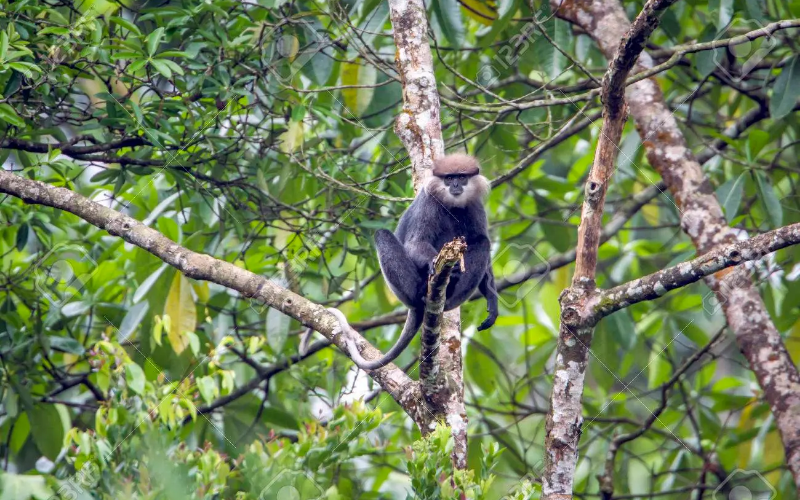
Subspecies
There are 4 recognized subspecies of the Sri Lankan elephant, according to the Mammals of Sri Lanka.
The purple-faced langur, Semnopithecus vetulus vetulus, is a species of purple-faced langur found in the southern lowland wet zone “The color of the water varies widely. The upper torso is black with a light brown cap and a well-defined silvery rump patch that extends to the legs. White whiskers that stand out. The tail has a white tint as well. The white variants of these subspecies can be found in large numbers. They might range from completely white to partially white leucistic.”
The western purple-faced langur, also known as the north lowland langur, Purple-faced langur, Semnopithecus Vetulus Nestor, is found in the wet zone “It is the tiniest of all the subspecies in the genus. The upper torso is dark grayish brown, with a light grayish brown rump patch, darker grayish brown legs, and a white cap. The legs are darker grayish brown, and the legs are darker grayish brown.”
The purple-faced langur, Semnopithecus Vetulus Philbricki, is a species of purple-faced langur that lives in the dry zone “The most numerous subspecies. Dark hat, grayish-brown torso, ill-defined grayish rump patch, and grayish rump patch. Prominent white cheekbones with tufts on either side. A slimy tail that is unusually lengthy.”
The montane purple-faced langur, also known as the Bear Monkey, Semnopithecus Vetulus Monticola, is a monkey that lives in the mountains of central Africa “Coat in a dark grayish-brown color. A large but ill-defined whitish rump patch can be seen on the back. White cheek tufts are prominent, and the crown is a pale brownish-gray color. Because of the frigid climate in which they reside, their fur is long and shaggy.”
The skull and pelage traits, as well as the body size, of each of the four identifiable subspecies, are distinct from one another. The western purple-faced langur is one of the world’s most endangered primates, ranking among the top 25 most endangered species on the planet. The majority of langur groups consist of only one adult male.
A putative subspecies of Semnopithecus Vetulus Harti has been identified, although its validity has not yet been determined. The skins of this subspecies have been discovered on the Jaffna peninsula and in the area north of the Vavuniya river. This subspecies is distinguished by the presence of yellowish golden hair on its head as well as a golden gloss on its fur. Aside from these variations, the anatomy and all other elements of the Semnopithecus Vetulus Philbricki are very similar to those of the Semnopithecus Vetulus Philbricki.
DNA and vocal data suggest that the purple-faced langur is more closely related to the gray langurs of the genus Semnopithecus than to the purple-faced langur, which is conventionally classified within the species Trachypithecus based on morphological similarities.
There are 4 recognized subspecies of the Sri Lankan elephant. Purple-faced langur, Semnopithecus vetulus vetulus, is found in the southern lowland wetzone. The white variants of this subspecies can be found in large numbers. The western purple-faced langur is one of the world’s most endangered primates. A putative subspecies of Semnopithecus vetulus harti has been identified. This subspecies has yellowish golden hair on its head and a golden gloss to its fur.
Habitat and Status of Purple-Faced Langur
Known as the “wet zone,” the purple-faced langur can be found in closed-canopy forests in Sri Lanka’s mountains and southwestern region, where it can be found in closed-canopy forests. Forested areas cover only 19 percent of Sri Lanka’s total land area. This habitat declined from 80 percent in 1980 to around 25 percent in 2001, according to the U.S. Geological Survey. At the moment, this range has been reduced to less than 3 percent. The range encompasses some of Sri Lanka’s most densely inhabited lowland rainforest areas, including the capital city of Colombo. Consequently, as a result of deforestation, the langurs’ home ranges are now exposed to direct sunlight. Purple-faced langurs are most typically seen in small, widely dispersed groups, rather than in large groupings. Ninety percent of the langur’s range is now occupied by humans, indicating that the langur is no longer endangered. Populations are dangerously low both within and between sites, and this is a concern. Cropland encroachment on the range, grazing, altering agriculture, road construction, soil loss/erosion, deforestation, poisoning from crop-raiding prevention, and hunting for medicine and food are all potential threats to this species.
Due to human encroachment, its range has been significantly reduced, yet it can still be found in Sinharaja, Kitulgala, Kandalama, Mihintale, the mountains of Horton Plains National Park, and the rainforests around the city of Galle.

Behaviour and Ecology
Diet
The purple-faced langur is mostly a folivore, but it will also eat fruits, flowers, and seeds in addition to leaves. Fruit such as jak (Artocarpus heterophyllus), rambutan (Nephelium lappaceum), banana (Musa balbisiana), and mango (Mangifera indica) may provide up to 50% of their diet in cultivated areas, despite the fact that they typically shun human habitations. Among the foods obtained in the wild are the fruits of Dimocarpus longan and Drypetes sepiaria, as well as other plants. The purple-faced langur’s digestion has been evolved to acquire the majority of its nutrients and energy requirements from complex carbohydrates found in leaves, with the assistance of a particular stomach bacteria strain. The ability to obtain appropriate nourishment may be compromised in areas where the species’ diet is currently strongly reliant on cultivated fruits. Fruit may be more readily available throughout certain seasons, which may enhance this impact.
T. Vetulus has a less diversified food than S. priam, with a higher proportion of leaves in the diet of the former. Holoptelea integrifolia, Hydnocarpus venenata, Macaranga peltata, Manilkara hexandra, Mikania scandens, Mischodon zeylanica, Pterospermum suberuleum, Tetrameles nudiflorum, Vitex altissima, and Wrightia angustifolia are some of the food plants that have been identified. In mixed feeding groups, it was discovered that the purple-faced langur was outnumbered by tufted gray langurs.
Communication
Individual purple-faced langurs are frequently distinguished from one another by their loud sounds. Extremely loud barks, whoops, and residuals are the three types of elements that make up a call signal. Individuals can be distinguished based on the number of phrases and residuals they use during a phone call. Calls are more frequent in the morning, and they are primarily triggered by territorial disputes between nearby groups. More calls are made during bright days than during cloudy days. Evenings are when the most calls are received. Daytime calls are frequently more effective in protecting house ranges. The harsh barking call of the highland version, in particular, can be mistaken for the roar of a predator such as a leopard, due to its high-pitched pitch. The purple-faced langur’s calls are distinct from those of any of the other subspecies of the langur. Environmental characteristics, as well as anthropogenic disturbance, have an impact on call timings. Members of a group can utilize vocalization to warn one another of predators, attract mates, defend territory, and locate other members of the group. The ability to vocalize is particularly crucial for use in conservation, especially because they are difficult to watch in their natural environment. Adult males are the most outspoken members of the group as a whole. Defensive whooping calls are accompanied by a flurry of visual and mechanical displays to show support. The use of vocalizations can also aid in the determination of taxonomic identity. As a result of these and other known predators of the tufted gray langur, the main potential predators of this species are believed to be leopards, followed seldom by Indian pythons and mugger crocodiles. Black eagles, spot-bellied eagle-owls, and probably other larger birds of prey constitute a hazard to young or infirm langurs, and they are particularly dangerous to young or infirm langurs. Purple-faced langurs are sometimes preyed upon by monitor lizards (possibly through scavenging or picking off the young or sickly)
Conservation
A number of conservation plans call for the management of existing protected areas, as well as the identification, protection, and enhancement of new areas and corridors within ranges. Efforts to increase population size may be beneficial to survival. It might be advantageous to reduce confrontations between humans and langurs. In order for langurs to securely traverse between ranges, rope bridges might be constructed, which would reduce the number of times they cross power lines and roadways. It is possible that replanting pine plantations with native species that are used by these langurs will expand their preferred habitat as well. Local people are being educated on conservation issues, with an emphasis on compassion and kindness, as well as the value and necessity of these species to the entire biodiversity of the ecosystem, through public education.
Conclusion
In conclusion, encountering the Purple-faced Langur in Sri Lanka is a truly remarkable experience. Ceylon Wild Tours and Share Traveller offers expertly guided tours to witness these incredible primates in their natural habitat. Through responsible tourism, we can help protect these endangered animals and their habitat, ensuring they are around for generations to come. Don’t miss out on the opportunity to witness these majestic creatures up close and personal with Ceylon Wild Tours. Book your tour today and let us take you on an unforgettable journey through the lush rainforests of Sri Lanka.

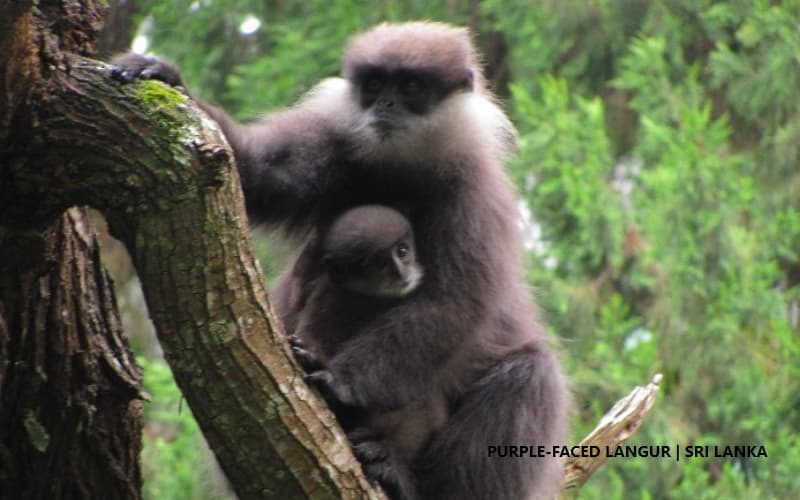




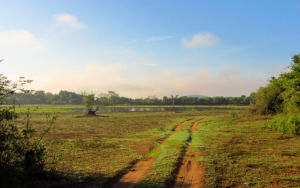
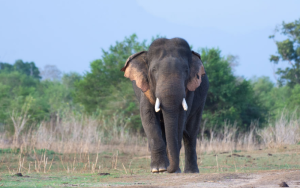
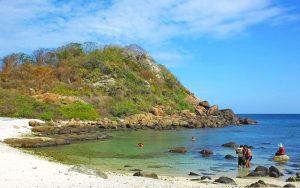
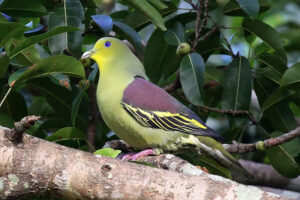
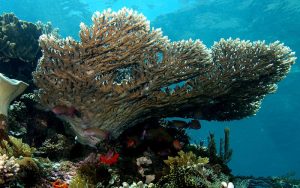

One thought on “Purple-faced Langur | Sri Lanka”
Useful information